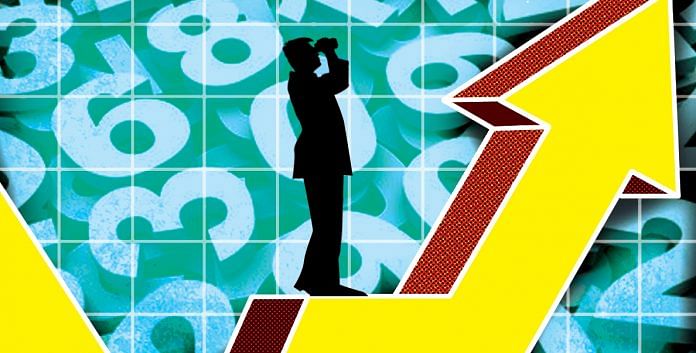New Delhi: The Government of India Tuesday revised its GDP (gross domestic product) growth estimate for 2021-22 to 8.7 per cent, lower than its earlier estimate of 8.9 per cent, according to provisional estimates released by the National Statistics Office (NSO).
In absolute terms, growth in GDP in 2021-22 was 1.5 per cent higher than the last pre-pandemic year, showing that the economy has recovered most of the losses suffered during Covid. In its first advance estimates released in January, the government had projected the economy to grow at 9.2 per cent in 2021-22.
Reasons that might have prompted this revision in estimated growth include economic disruptions caused by the third wave of the Covid-19 pandemic, and spike in inflation due to the Russia-Ukraine conflict.
Further, the government’s statistics department has projected nominal GDP growth for 2021-22 at a whopping 19.5 per cent, marginally up from the earlier estimate of 19.4 per cent. Nominal GDP is the GDP based on current prices while real GDP factors in inflation or surge in prices compared to the previous year.
The sharp upward revision in nominal GDP has helped the government lower its fiscal deficit as a ratio of GDP in 2021-22.
Fiscal deficit is the gap between the government’s receipts and spending where the latter is more than the former. The fiscal deficit for 2021-22 settled at Rs 15.87 lakh crore or 6.7 per cent of GDP, compared to the revised target of Rs 15.9 lakh crore, or 6.9 per cent of the GDP.
Reacting to the GDP growth figures, Chief Economic Adviser V. Anantha Nageswaran told mediapersons, “The Indian economy consolidated its recovery in 2021-22 with most constituents surpassing the pre-pandemic levels.”
“However, GDP growth in 2022-23 is faced with global headwinds such as high global prices of commodities with significant import dependency, tightening of monetary policies in most countries, supply chain bottlenecks and potential global recession with impact on export growth in India,” he added.
Even at 8.7 per cent, India’s real GDP growth will be the fastest in the current series, which dates back 17 years. Data from before 2005 is not comparable to the current series since the methodology and definition of GDP calculation was changed in 2015 to include gross value added (GVA).
In 2015, the government changed the base year used to calculate GDP growth to 2011-12. There was also the switch to calculating GDP on market prices rather than factor costs, which would take into account the gross value addition of goods and services.
The 8.7 per cent GDP growth is primarily on account of a low base (year-on-year growth) as India’s GDP contracted 6.6 per cent in 2020-21 owing to the nationwide lockdown to curb the spread of Covid-19. In 2021-22, the gross value added at basic prices grew 8.1 per cent compared with 8.3 per cent predicted earlier.
In the fourth quarter of 2021-22, the Indian economy grew at 4.1 per cent, compared to 5.4 per cent in the third quarter of 2021-22 and 2.5 per cent in 2020-2021.
Among the three broad sectors, industry — which grew at 10.3 per cent — saw the highest growth in 2021-22, compared to a contraction of 3.3 per cent in 2020-21. Industry was followed by the services sector, which grew at 8.4 per cent in 2021-22 compared to 7.8 per cent in 2020-21, and agriculture, which grew at 3 per cent in 2021-22.
On the expenditure side, gross fixed capital formation, used as a proxy for investments in the economy, grew at 15.8 per cent in 2021-22, higher than the previous estimate of 15 per cent.
Meanwhile, private final consumption expenditure, an indicator for demand in the economy that contributes the most to GDP, grew at 7.9 per cent in 2021-22, while government consumption grew at 2.6 per cent.
Also Read: Why Modi govt will meet its tax targets this year without much effort despite slow growth
A look at latest GDP numbers in charts:
Demand improving, fall in govt spending
At 7.9 per cent growth in 2021-22, the private final consumption expenditure (PFCE) shows that demand is now better than what it was before the Covid-19 pandemic. In 2021-22, the PFCE was about Rs 83.8 lakh crore, compared to Rs 77.6 lakh crore in 2020-21 and Rs 82.6 lakh crore in the pre-pandemic year 2019-20.
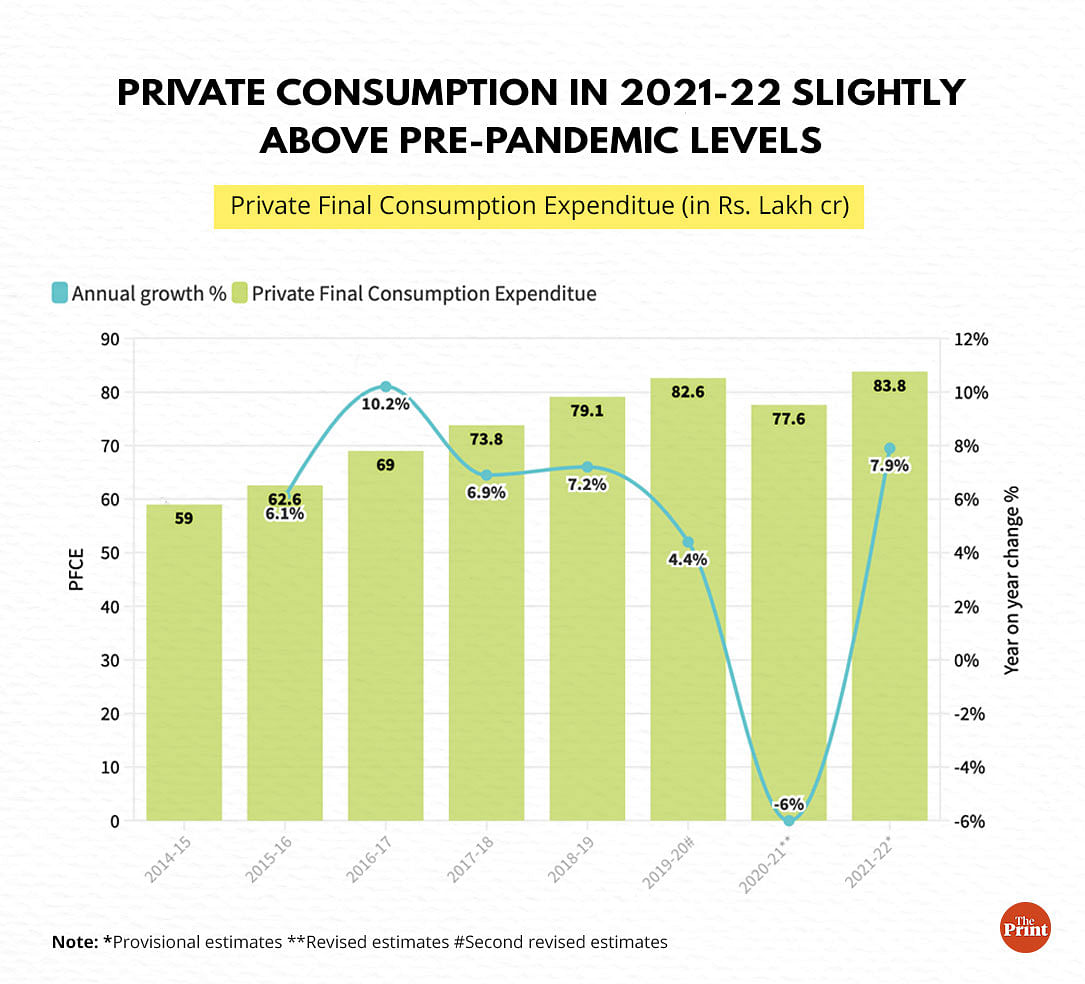
Government final consumption expenditure (GFCE), which is a measure of the overall government spending on goods and services, was 10.7 per cent of the GDP in 2021-22. This shows that government spending as a percentage of GDP fell marginally in 2021-22, compared to the previous year.
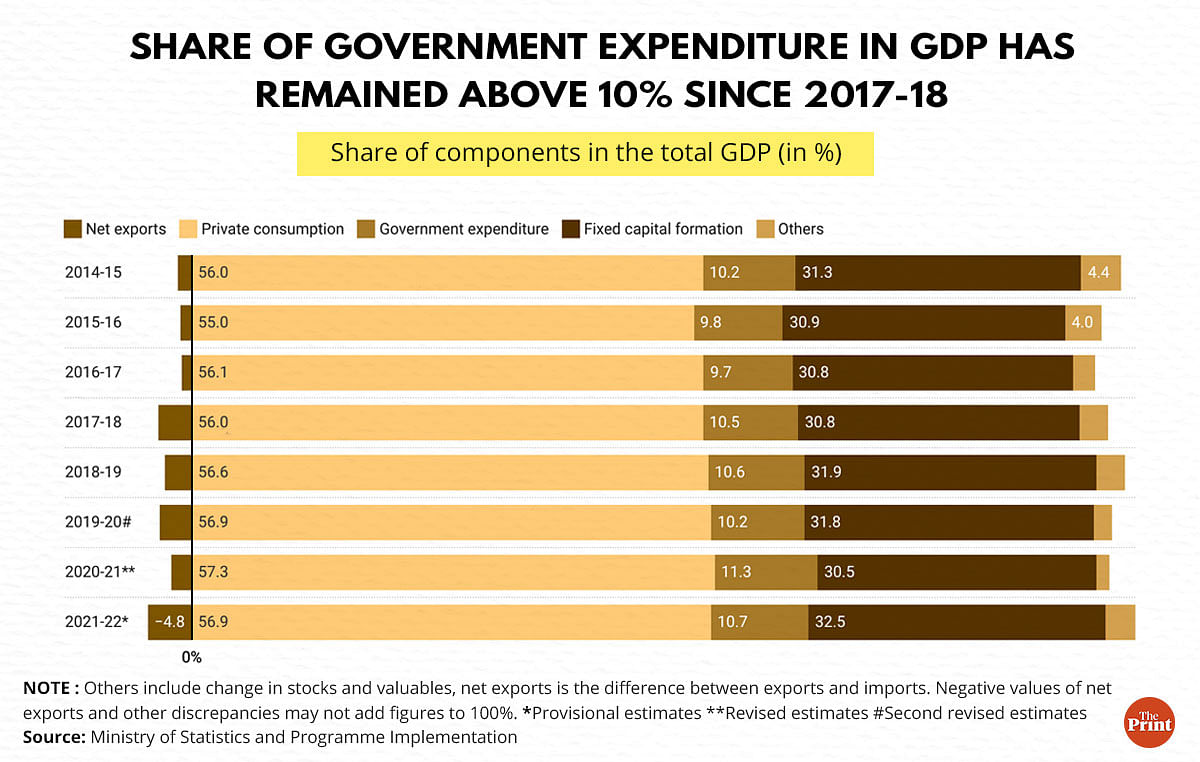
Creation of capital
The gross fixed capital formation (GFCF) accounts for the addition of fixed assets in a financial year. Hence, this is a proxy for measuring investments. During the pandemic year, 2020-21, the GFCF had fallen by 10 per cent to Rs 41.3 lakh crore from Rs 46.3 lakh crore.
In 2021-22, the GFCF has risen to Rs 47.8 lakh crore, which is a 15 per cent jump from the first pandemic year. Compared to the pre-pandemic year, 2019-20, the fixed capital creation was 3.7 per cent higher in 2021-22.
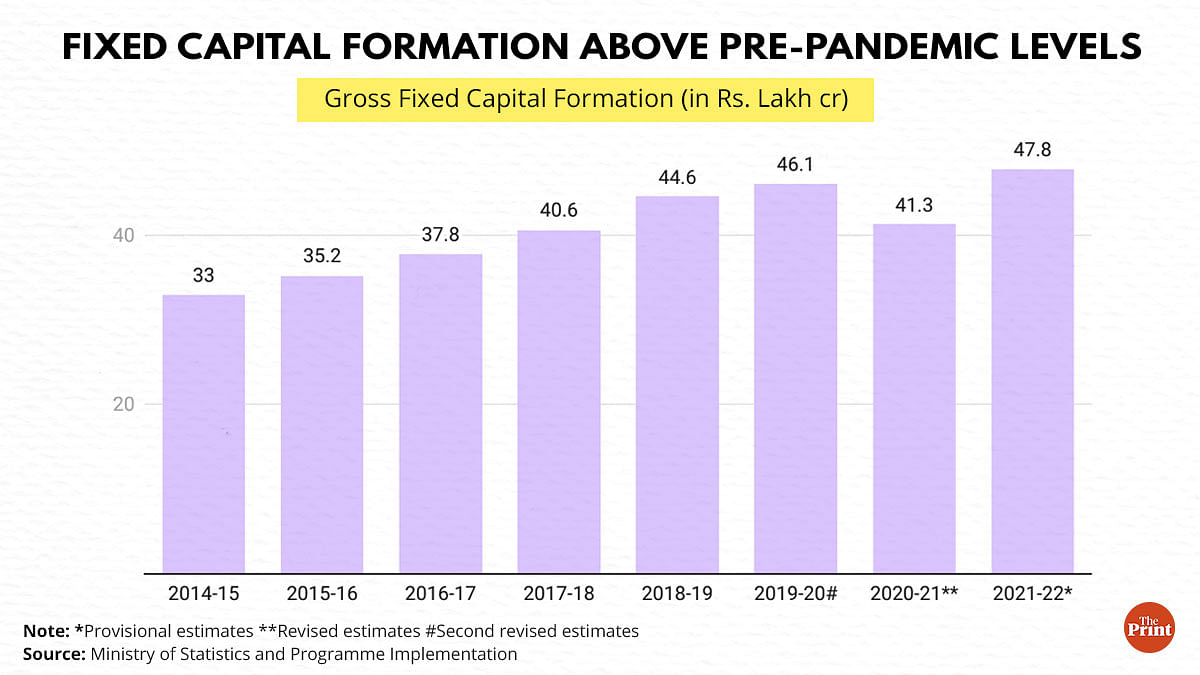
Net exports
Net exports are the difference between the total worth of goods exported and that of a country’s imports. A country earns money on the goods it produces and exports. Similarly, a country has to pay to import goods produced in other countries.
India’s imports have historically outnumbered its exports, but the gap in 2021-22 was quite wide.
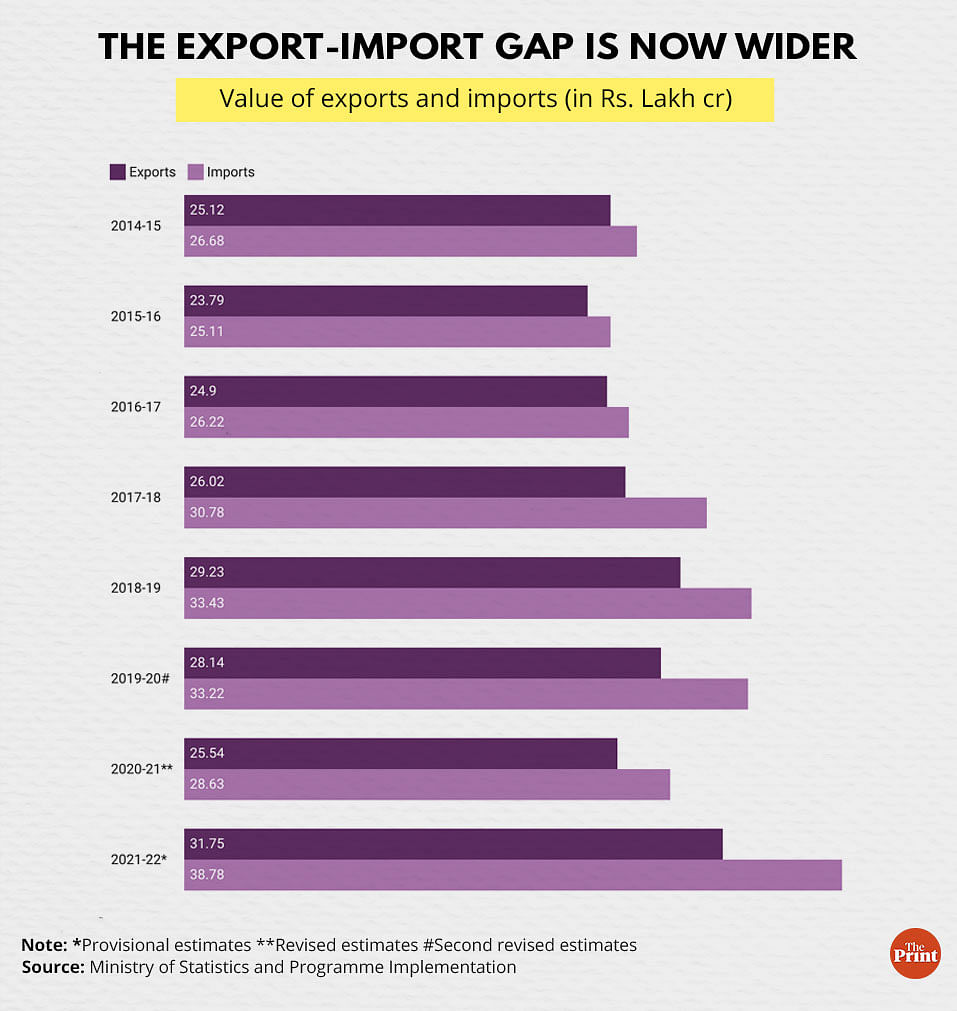
In 2021-22, India exported goods worth over Rs 31 lakh crore. At the same time, its imports — at Rs 38.78 lakh crore — were 22 per cent higher. This gap was about 12 per cent last year and 18 per cent in 2019-20.
Real, nominal GDP
Real GDP is measured on the basis of historical prices — India uses 2011-12 prices as the base. Nominal GDP, meanwhile, is measured at present-day or current prices. The difference between real and nominal GDP tells us the extent to which GDP estimates are inflated due to prices.
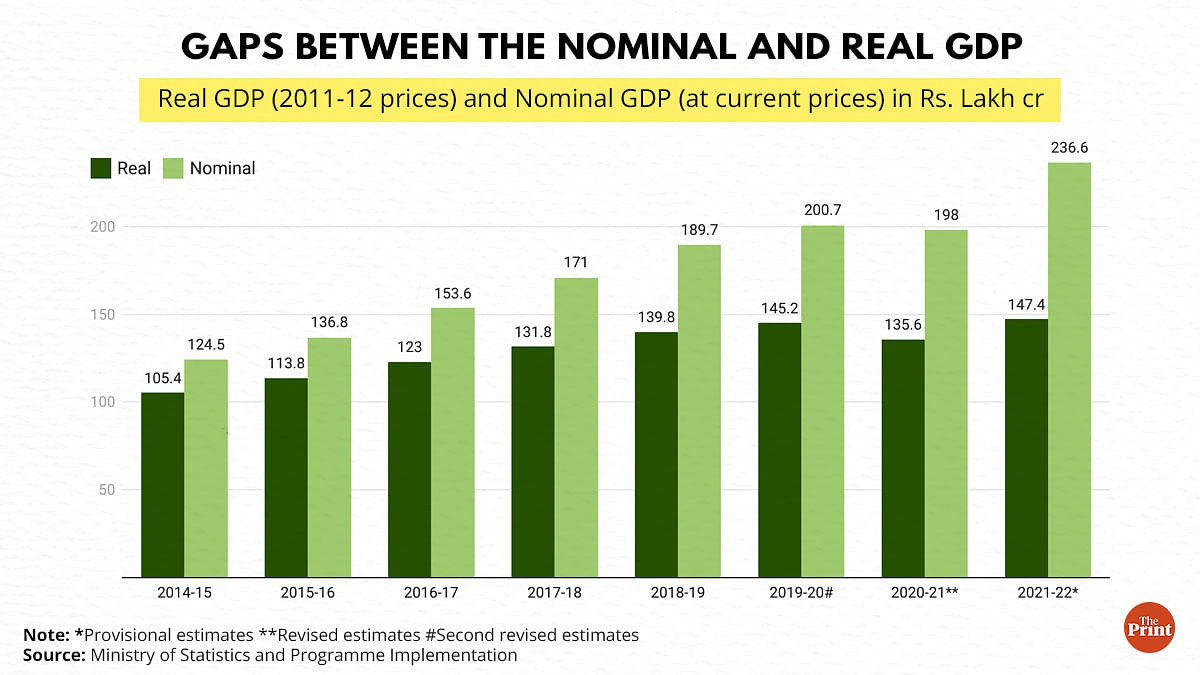
In 2021-22, India’s real GDP stood at Rs 147.4 lakh crore while nominal GDP was reported to be Rs 236.6 lakh crore. This means that if the goods and services sold today were at 2011-12 prices, they are being written at a 60 per cent higher value today.
(Edited by Amrtansh Arora)
Also Read: India’s economy likely lost speed on Covid curbs before Ukraine war


